check engine light PONTIAC VIBE 2010 Owners Manual
[x] Cancel search | Manufacturer: PONTIAC, Model Year: 2010, Model line: VIBE, Model: PONTIAC VIBE 2010Pages: 318, PDF Size: 1.7 MB
Page 1 of 318
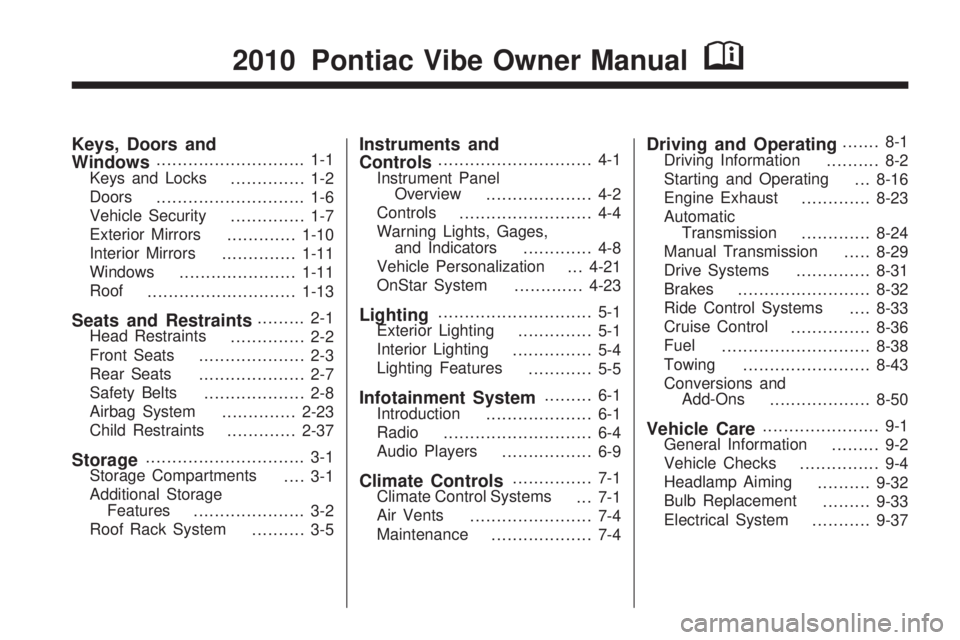
Keys, Doors and
Windows............................ 1-1
Keys and Locks .............. 1-2
Doors ............................ 1-6
Vehicle Security .............. 1-7
Exterior Mirrors .............1-10
Interior Mirrors ..............1-11
Windows ...................... 1-11
Roof ............................ 1-13
Seats and Restraints......... 2-1
Head Restraints .............. 2-2
Front Seats .................... 2-3
Rear Seats .................... 2-7
Safety Belts ................... 2-8
Airbag System ..............2-23
Child Restraints .............2-37
Storage.............................. 3-1
Storage Compartments .... 3-1
Additional Storage Features ..................... 3-2
Roof Rack System .......... 3-5
Instruments and
Controls............................. 4-1
Instrument Panel Overview .................... 4-2
Controls ......................... 4-4
Warning Lights, Gages, and Indicators ............. 4-8
Vehicle Personalization . . . 4-21
OnStar System .............4-23
Lighting............................. 5-1
Exterior Lighting .............. 5-1
Interior Lighting ............... 5-4
Lighting Features ............ 5-5
Infotainment System......... 6-1
Introduction .................... 6-1
Radio ............................ 6-4
Audio Players ................. 6-9
Climate Controls............... 7-1
Climate Control Systems ... 7-1
Air Vents ....................... 7-4
Maintenance ................... 7-4
Driving and Operating....... 8-1
Driving Information .......... 8-2
Starting and Operating . . . 8-16
Engine Exhaust .............8-23
Automatic Transmission .............8-24
Manual Transmission .....8-29
Drive Systems ..............8-31
Brakes ......................... 8-32
Ride Control Systems ....8-33
Cruise Control ...............8-36
Fuel ............................ 8-38
Towing ........................ 8-43
Conversions and Add-Ons ................... 8-50
Vehicle Care...................... 9-1
General Information ......... 9-2
Vehicle Checks ............... 9-4
Headlamp Aiming ..........9-32
Bulb Replacement .........9-33
Electrical System ...........9-37
2010 Pontiac Vibe Owner ManualM
Page 14 of 318
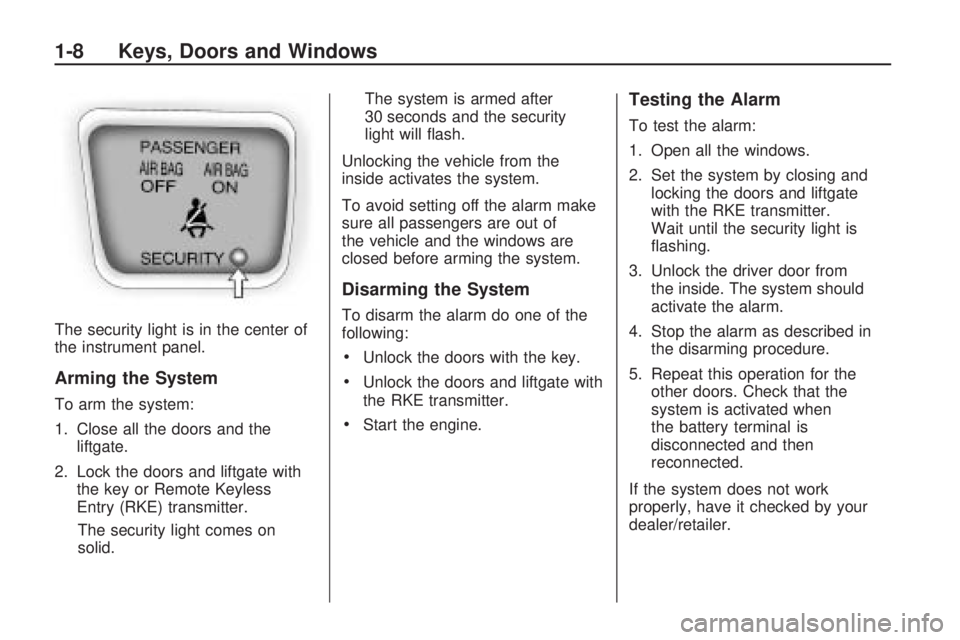
The security light is in the center of
the instrument panel.
Arming the System
To arm the system:
1. Close all the doors and theliftgate.
2. Lock the doors and liftgate with the key or Remote Keyless
Entry (RKE) transmitter.
The security light comes on
solid. The system is armed after
30 seconds and the security
light will flash.
Unlocking the vehicle from the
inside activates the system.
To avoid setting off the alarm make
sure all passengers are out of
the vehicle and the windows are
closed before arming the system.
Disarming the System
To disarm the alarm do one of the
following:
•Unlock the doors with the key.
•Unlock the doors and liftgate with
the RKE transmitter.
•Start the engine.
Testing the Alarm
To test the alarm:
1. Open all the windows.
2. Set the system by closing and locking the doors and liftgate
with the RKE transmitter.
Wait until the security light is
flashing.
3. Unlock the driver door from the inside. The system should
activate the alarm.
4. Stop the alarm as described in the disarming procedure.
5. Repeat this operation for the other doors. Check that the
system is activated when
the battery terminal is
disconnected and then
reconnected.
If the system does not work
properly, have it checked by your
dealer/retailer.
1-8 Keys, Doors and Windows
Page 15 of 318

How the System Alarm is
Activated
The system activates the alarm if:
•A locked door or the liftgate
is unlocked or opened without the
RKE transmitter.
•A locked door is unlocked or
opened without the key.
•The liftgate is unlocked or
opened with the key.
•The battery is reconnected.
•The side windows are tapped or
broken.
Do not leave the key or device that
disarms or deactivates the theft
deterrent system in the vehicle.
Immobilizer
See Radio Frequency Statement
(US, Can) on page 12-16 for
information regarding Part 15 of
the Federal Communications
Commission (FCC) Rules and
RSS-210/211 of Industry and
Science Canada.
Immobilizer Operation
This vehicle has a passive
theft-deterrent system.
You do not have to manually arm or
disarm the system.
The system is automatically armed
when the key is removed from
the ignition.
The security light is in the center of
the instrument panel. It comes
on if there is a problem with arming
or disarming the theft-deterrent
system. The security light flashes when the
system is armed.
Only the correct key starts the
vehicle.
If the engine does not start, there
could be a problem with the
theft-deterrent system. Turn the
ignition off and try again.
If the engine still does not start, and
the key appears to be undamaged,
try another ignition key. Check
the fuse. See
Fuses and Circuit
Breakers on page 9-38 .
If the engine still does not start with
the other key, the vehicle needs
service. If the vehicle does start, the
first key may be faulty. See your
dealer/retailer who can service the
theft-deterrent system and have
a new key made.
Keys, Doors and Windows 1-9
Page 90 of 318

Cigarette Lighter
For vehicles with a lighter, push
the lighter down and it will pop up
when it is ready to be used. The
ignition switch must be in the
ACC/ACCESSORY or ON/RUN
position to use the lighter.
Notice:Holding a cigarette
lighter in while it is heating does
not let the lighter back away from
the heating element when it is hot.
Damage from overheating can
occur to the lighter or heating
element, or a fuse could be blown.
Do not hold a cigarette lighter in
while it is heating.
It is not recommended to use the
cigarette lighter to plug in auxiliary
electrical equipment. Use the
accessory power outlet for phones and other electrical equipment. See
Power Outlets (Accessory Power
Outlets) on page 4-6
orPower
Outlets (115 Volt Alternating
Current) on page 4-7 .
Ashtrays
For vehicles with a removable
ashtray, it is located in the front
cupholder in the center console
storage area.
Notice:If papers, pins, or other
�ammable items are put in the
ashtray, hot cigarettes or other
smoking materials could ignite
them and possibly damage the
vehicle. Never put �ammable
items in the ashtray.
Warning Lights,
Gages, and Indicators
Warning lights come on when there
could be a problem with a vehicle
function. Some warning lights come
on briefly when the engine is started
to indicate they are working.
Gages can indicate when there
could be a problem with a vehicle
function. Often gages and warning
lights work together to indicate
a problem with the vehicle.
When one of the warning lights
comes on and stays on while driving,
or when one of the gages shows
there may be a problem, check the
section that explains what to do.
Follow this manual’s advice. Waiting
to do repairs can be costly and even
dangerous.
4-8 Instruments and Controls
Page 96 of 318
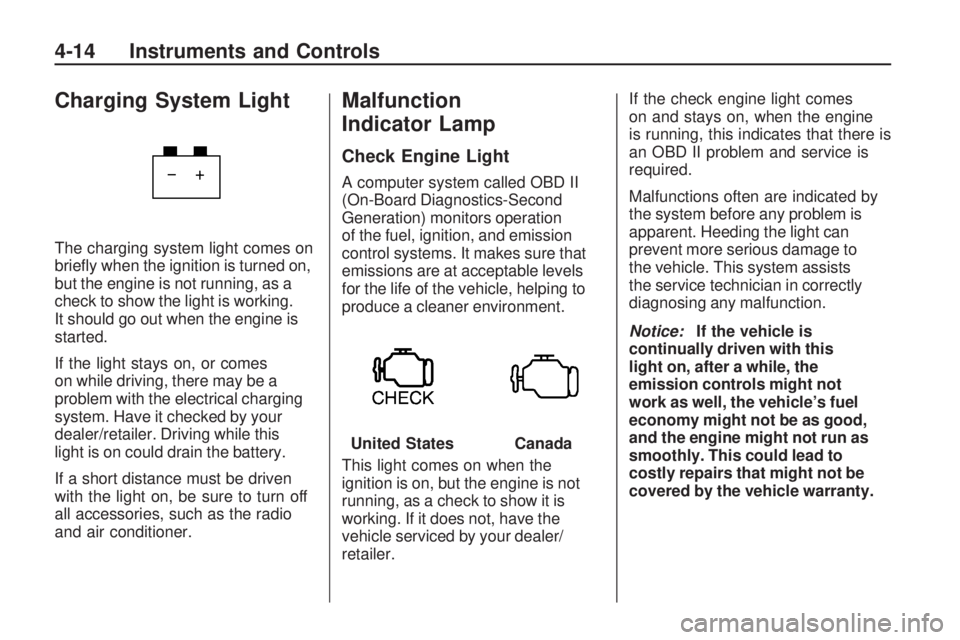
Charging System Light
The charging system light comes on
briefly when the ignition is turned on,
but the engine is not running, as a
check to show the light is working.
It should go out when the engine is
started.
If the light stays on, or comes
on while driving, there may be a
problem with the electrical charging
system. Have it checked by your
dealer/retailer. Driving while this
light is on could drain the battery.
If a short distance must be driven
with the light on, be sure to turn off
all accessories, such as the radio
and air conditioner.
Malfunction
Indicator Lamp
Check Engine Light
A computer system called OBD II
(On-Board Diagnostics-Second
Generation) monitors operation
of the fuel, ignition, and emission
control systems. It makes sure that
emissions are at acceptable levels
for the life of the vehicle, helping to
produce a cleaner environment.
This light comes on when the
ignition is on, but the engine is not
running, as a check to show it is
working. If it does not, have the
vehicle serviced by your dealer/
retailer.If the check engine light comes
on and stays on, when the engine
is running, this indicates that there is
an OBD II problem and service is
required.
Malfunctions often are indicated by
the system before any problem is
apparent. Heeding the light can
prevent more serious damage to
the vehicle. This system assists
the service technician in correctly
diagnosing any malfunction.
Notice:
If the vehicle is
continually driven with this
light on, after a while, the
emission controls might not
work as well, the vehicle’s fuel
economy might not be as good,
and the engine might not run as
smoothly. This could lead to
costly repairs that might not be
covered by the vehicle warranty.
United StatesCanada
4-14 Instruments and Controls
Page 98 of 318
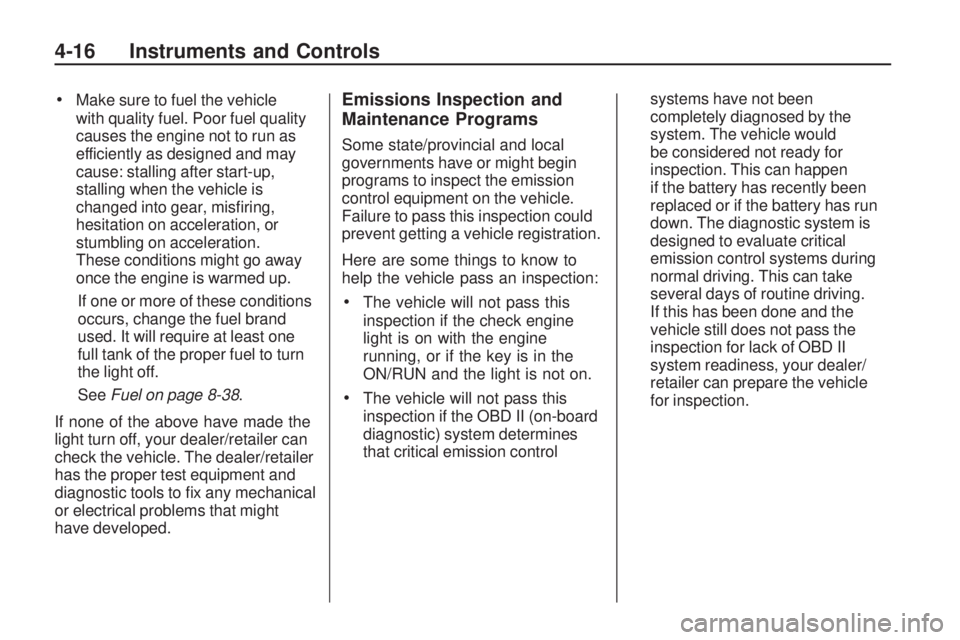
•Make sure to fuel the vehicle
with quality fuel. Poor fuel quality
causes the engine not to run as
efficiently as designed and may
cause: stalling after start-up,
stalling when the vehicle is
changed into gear, misfiring,
hesitation on acceleration, or
stumbling on acceleration.
These conditions might go away
once the engine is warmed up.If one or more of these conditions
occurs, change the fuel brand
used. It will require at least one
full tank of the proper fuel to turn
the light off.
See Fuel on page 8-38.
If none of the above have made the
light turn off, your dealer/retailer can
check the vehicle. The dealer/retailer
has the proper test equipment and
diagnostic tools to fix any mechanical
or electrical problems that might
have developed.Emissions Inspection and
Maintenance Programs
Some state/provincial and local
governments have or might begin
programs to inspect the emission
control equipment on the vehicle.
Failure to pass this inspection could
prevent getting a vehicle registration.
Here are some things to know to
help the vehicle pass an inspection:
•The vehicle will not pass this
inspection if the check engine
light is on with the engine
running, or if the key is in the
ON/RUN and the light is not on.
•The vehicle will not pass this
inspection if the OBD II (on-board
diagnostic) system determines
that critical emission control systems have not been
completely diagnosed by the
system. The vehicle would
be considered not ready for
inspection. This can happen
if the battery has recently been
replaced or if the battery has run
down. The diagnostic system is
designed to evaluate critical
emission control systems during
normal driving. This can take
several days of routine driving.
If this has been done and the
vehicle still does not pass the
inspection for lack of OBD II
system readiness, your dealer/
retailer can prepare the vehicle
for inspection.
4-16 Instruments and Controls
Page 100 of 318

If the regular brake system warning
light is also on, there are no antilock
brakes and there is a problem with
the regular brakes. SeeBrake
System Warning Light on page 4-17 .
Service All-Wheel Drive
Light
This light will come on briefly when
the ignition is turned on, and the
engine is not running, as a check
to show you it is working.
It should go out when the engine is
started. It should go out when the
engine is started. If it stays on, or
comes on while you are driving, you
may have a problem with the system.
Have it checked by your dealer/
retailer.
The four-wheel-drive indicator will
light up when the All-Wheel drive is
active.
Speed Sensitive Power
Steering (SSPS) Warning
Light
Vehicles with this feature, have a
warning light that comes on briefly
when the ignition is turned to
ON/RUN as a check to show it
is working.
If the warning light does not come
on, have it fixed so it will be able to
warn if there is a problem.
If the warning light stays on, or
comes on while driving, the Speed
Sensitive Power Steering may not be
working. See your dealer/retailer for
service.
StabiliTrak®Indicator
Light
This light warns that there is a
problem with the Traction Control
System (TCS) or the Vehicle
Stability Control (VSC) system.
The light comes on when the ignition
is turned to ON/RUN.
If the light comes on while driving,
the system is not working.
The TCS light comes on when the
VSC system warning light comes on,
even if the TRAC OFF button is not
pressed.
See StabiliTrak System on
page 8-35 for more information on
Vehicle Stability Control System.
4-18 Instruments and Controls
Page 101 of 318

SeeTraction Control System (TCS)
on page 8-33 for more information.
Contact your dealer/retailer, if
the light does not come on or if it
stays on.
Traction Control System
(TCS) Warning Light
This warning light comes on briefly
when the ignition is turned to
ON/RUN.
It also comes on when the Traction
Control System is turned off by
pressing the TRAC OFF button.
See Traction Control System (TCS)
on page 8-33 for more information. If it stays on or comes on while
driving, there is a problem with the
Traction Control System (TCS),
contact your dealer/retailer.
Tire Pressure Light
This light should come on briefly as
the engine is started.
If there is a tire with low tire
pressure, the light will stay on
or come back on.
See
Tire Pressure Monitor
Operation on page 9-52 for more
information.
Engine Oil Pressure
Light
{CAUTION
Do not keep driving if the oil
pressure is low. The engine can
become so hot that it catches fire.
Someone could be burned. Check
the oil as soon as possible and
have the vehicle serviced.
Notice: Lack of proper engine
oil maintenance can damage
the engine. The repairs would
not be covered by the vehicle
warranty. Always follow the
maintenance schedule in this
manual for changing engine oil.
The oil pressure light should come
on briefly as the engine is started. If it
does not come on have the vehicle
serviced by your dealer/retailer.
Instruments and Controls 4-19
Page 166 of 318
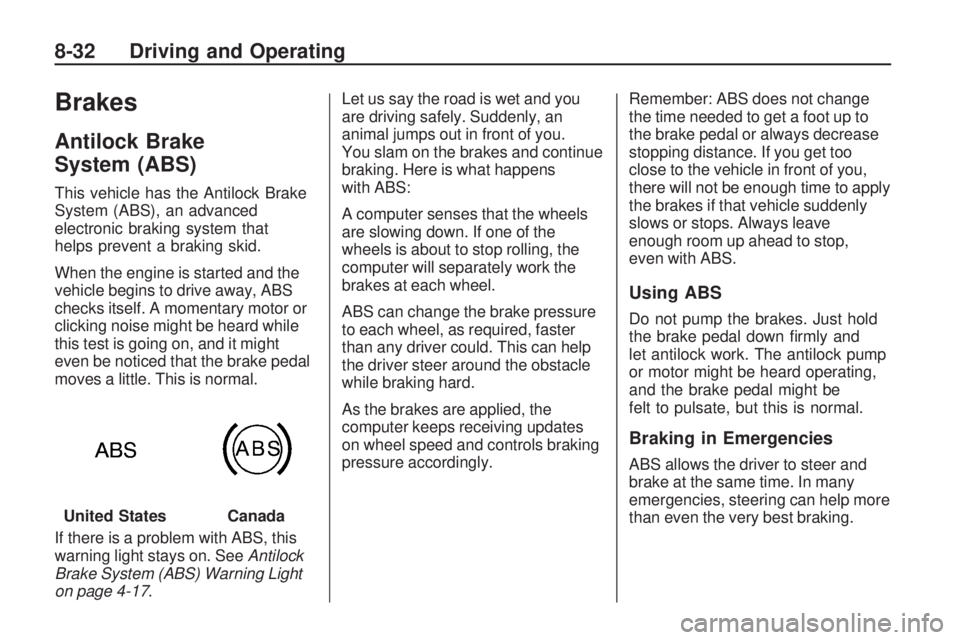
Brakes
Antilock Brake
System (ABS)
This vehicle has the Antilock Brake
System (ABS), an advanced
electronic braking system that
helps prevent a braking skid.
When the engine is started and the
vehicle begins to drive away, ABS
checks itself. A momentary motor or
clicking noise might be heard while
this test is going on, and it might
even be noticed that the brake pedal
moves a little. This is normal.
If there is a problem with ABS, this
warning light stays on. SeeAntilock
Brake System (ABS) Warning Light
on page 4-17. Let us say the road is wet and you
are driving safely. Suddenly, an
animal jumps out in front of you.
You slam on the brakes and continue
braking. Here is what happens
with ABS:
A computer senses that the wheels
are slowing down. If one of the
wheels is about to stop rolling, the
computer will separately work the
brakes at each wheel.
ABS can change the brake pressure
to each wheel, as required, faster
than any driver could. This can help
the driver steer around the obstacle
while braking hard.
As the brakes are applied, the
computer keeps receiving updates
on wheel speed and controls braking
pressure accordingly.
Remember: ABS does not change
the time needed to get a foot up to
the brake pedal or always decrease
stopping distance. If you get too
close to the vehicle in front of you,
there will not be enough time to apply
the brakes if that vehicle suddenly
slows or stops. Always leave
enough room up ahead to stop,
even with ABS.
Using ABS
Do not pump the brakes. Just hold
the brake pedal down firmly and
let antilock work. The antilock pump
or motor might be heard operating,
and the brake pedal might be
felt to pulsate, but this is normal.
Braking in Emergencies
ABS allows the driver to steer and
brake at the same time. In many
emergencies, steering can help more
than even the very best braking.
United States
Canada
8-32 Driving and Operating
Page 169 of 318
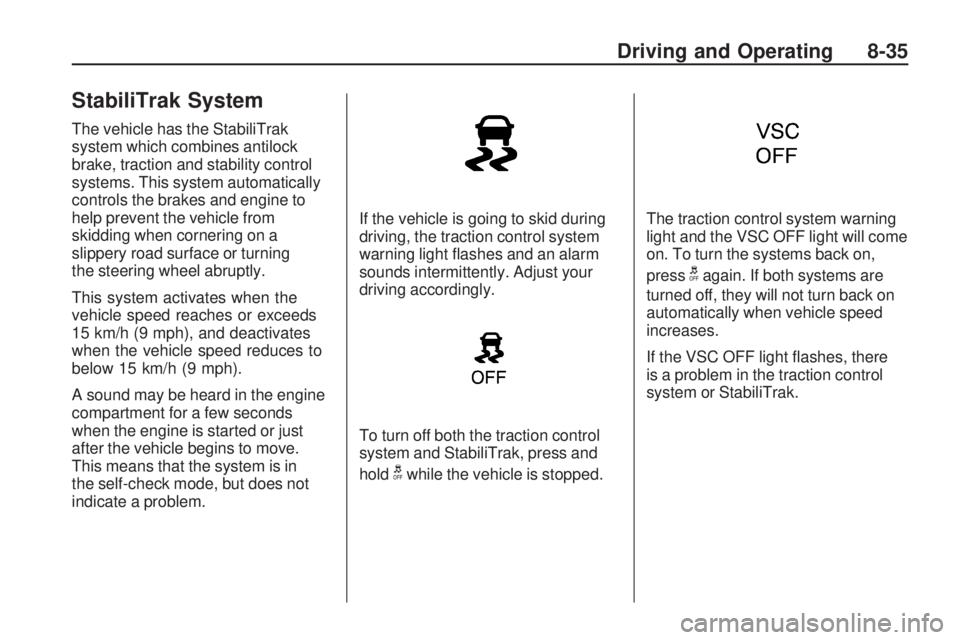
StabiliTrak System
The vehicle has the StabiliTrak
system which combines antilock
brake, traction and stability control
systems. This system automatically
controls the brakes and engine to
help prevent the vehicle from
skidding when cornering on a
slippery road surface or turning
the steering wheel abruptly.
This system activates when the
vehicle speed reaches or exceeds
15 km/h (9 mph), and deactivates
when the vehicle speed reduces to
below 15 km/h (9 mph).
A sound may be heard in the engine
compartment for a few seconds
when the engine is started or just
after the vehicle begins to move.
This means that the system is in
the self-check mode, but does not
indicate a problem.If the vehicle is going to skid during
driving, the traction control system
warning light flashes and an alarm
sounds intermittently. Adjust your
driving accordingly.
To turn off both the traction control
system and StabiliTrak, press and
hold
gwhile the vehicle is stopped.
The traction control system warning
light and the VSC OFF light will come
on. To turn the systems back on,
press
gagain. If both systems are
turned off, they will not turn back on
automatically when vehicle speed
increases.
If the VSC OFF light flashes, there
is a problem in the traction control
system or StabiliTrak.
Driving and Operating 8-35